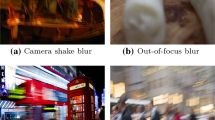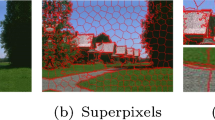Abstract
Motion blur is a common problem in digital photography. In the dim light, a long exposure time is needed to acquire a satisfactory photograph, and if the camera shakes during exposure, a motion blur is captured. Image deblurring has become a crucial image-processing challenge, because of the increased popularity of handheld cameras. Traditional motion deblurring methods assume that the blur degradation is shift-invariant; therefore, the deblurring problem can be reduced to a deconvolution problem. Edge-specific motion deblurring sharpened the strong edges of the image and then used them to estimate the blur kernel. However, this also enhanced noise and narrow edges, which cause ambiguity and ringing artifacts. We propose a hybrid-based single image motion deblurring algorithm to solve these problems. First, we separated the blurred image into strong edge parts and smooth parts. We applied the improved patch-based sharpening method to enhance the strong edge for kernel estimation, but for the smooth part, we used the bilateral filter to remove the narrow edge and the noise for avoiding the generation of ringing artifacts. Experimental results show that the proposed method is efficient at deblurring for a variety of images and can produce images of a quality comparable to other state-of-the-art techniques.






















Similar content being viewed by others
References
Gonzalez, R.C., Woods, R.E.: Digital Image Processing, 2nd edn. Prentice Hall, Englewood Cliffs (2002)
Richardson, W.H.: Bayesian-based iterative method of image restoration. J. Optic. Soc. Am. 62(1), 55–59 (1972)
Lee, J.H., Ho, Y.S.: High-quality non-blind image deconvolution with adaptive regularization. J. Vis. Commun. Image Represent. 22(7), 653–663 (2011)
Zhao, J., Feng, H., Xu, Z., Li, Q.: An improved image deconvolution approach using local constraint. Opt. Laser Technol. 44(2), 421–427 (2012)
Rav-Acha, A., Peleg, S.: Two motion-blurred images are better than one. Pattern Recognit. Lett. 26, 311–317 (2005)
Yuan, L., Sun, J., Quan, L., Shum, H.: Image deblurring with blurred/noisy image pairs. ACM Trans. Graph. 26(3), 1 (2007)
Zhuo, S., Guo, D., Sim, T.: Robust flash deblurring. In: IEEE Conference Society on Computer Vision and Pattern Recognition, pp. 2440–2447 (2010)
Zhang, H., Wipf, D., Zhang, Y.: Multi-observation blind deconvolution with an adaptive sparse prior. IEEE Trans. Pattern Anal. Mach. Intell. 36(8), 1628–1643 (2014)
Fergus, R., Singh, B., Hertzmann, A., Roweis, S.T., Freeman, W.T.: Removing camera shake from a single photograph. ACM Trans. Graph. 25(3), 787–794 (2006)
Shan, Q., Jia, J., Agarwala, A.: High-quality motion deblurring from a single image. ACM Trans. Graph. 27(3), 73 (2008)
Cho, S., Lee, S.: Fast motion deblurring. ACM Trans. Graph. 28(5), 145 (2009)
Levin, A., Weiss, Y., Durand, F., Freeman, W.T.: Understanding blind deconvolution algorithms. IEEE Trans. Pattern Anal. Mach. Intell. 33(12), 2354 (2011)
Wang, C., Sun, L., Cui, P., Zhang, J., Yang, S.: Analyzing image deblurring through three paradigms. IEEE Trans. Image Process. 21(1), 115–129 (2012)
Xu, L., Zheng, S., Jia, J.: Unnatural L0 Sparse Representation for Natural Image Deblurring. In: IEEE Computer Society Conference on Computer Vision and Pattern Recognition (2013)
Wang, C., Yue, Y., Dong, F., Tao, Y., Ma, X., Clapworthy, G., Lin, H., Ye, X.: Nonedge-specific adaptive scheme for highly robust blind motion deblurring of natural images. IEEE Trans. Image Process. 22, 884–897 (2013)
Sun, L., Cho, S., Wang, J., Hays, J.: Edge-based Blur Kernel Estimation Using Patch Priors. In: Proceedings of IEEE International Conference on Computational Photography (2013)
Sun, L., Cho, S., Wang, J., Hays, J.: Good image priors for non-blind deconvolution: generic vs specific. In: Proceedings of European Conference on Computer Vision, vol. 8692, pp. 231–246 (2014)
Zuo, W., Meng, D., Zhang, L., Feng, X., Zhang, D.: A generalized iterated shrinkage algorithm for non-convex sparse coding. In: Proceedings of the IEEE international conference on computer vision, pp. 217–224 (2013)
Yan, R., Shao, L.: Blind image blur estimation via deep learning. IEEE Trans. Image Process. 25(4), 1910–1921 (2016)
Schuler, C.J., Hirsch, M., Harmeling, S., Schölkopf, B.: Learning to deblur. IEEE Trans. Pattern Anal. Mach. Intell. 38(7), 1439–1451 (2016)
Canny, J.: A computational approach to edge detection. IEEE Trans. Pattern Anal. Mach. Intell. 6, 679–698 (1986)
Tsai, H.C., Wu, J.L.: An improved adaptive deconvolution algorithm for single image deblurring. Math. Probl. Eng. 2014(3), 1–11 (2014)
Krishnan, D., Fergus, R.: Fast image deconvolution using hyper-Laplacian priors. In: Proceedings of the 23rd Annual Conference on Neural Information Processing Systems(NIPS ’09), pp. 1033–1041 (2009)
Wang, Y., Yang, J., Yin, W., Zhang, Y.: A new alternating minimization algorithm for total variation image reconstruction. SIAM J. Imaging Sci. 1, 248–272 (2008)
Acknowledgements
This research is supported by the Ministry of Science and Technology, Taiwan, under Grants MOST 104-2221-E-005-090- and MOST105-2221-E-005-068.
Author information
Authors and Affiliations
Corresponding author
Rights and permissions
About this article
Cite this article
Chang, CF., Wu, JL. & Chen, KJ. A Hybrid Motion Deblurring Strategy Using Patch Based Edge Restoration and Bilateral Filter. J Math Imaging Vis 60, 1081–1094 (2018). https://doi.org/10.1007/s10851-018-0797-x
Received:
Accepted:
Published:
Issue Date:
DOI: https://doi.org/10.1007/s10851-018-0797-x




